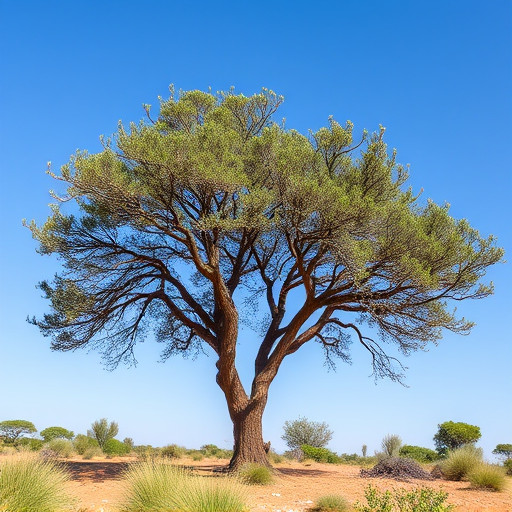Acacia trees, native to warm regions worldwide, exhibit diverse distributions in California and India due to varying climates. In California, they thrive in arid conditions with compact forms and waxy leaves for water conservation. India's varied climate allows Acacias to flourish from deserts to forests, showcasing wide adaptations in size and leaf types. These species significantly contribute to biodiversity and serve as environmental indicators in both regions.
Acacia in California vs. India: Unraveling the Unique Characteristics and Cultural Significance
The Acacia tree, with its distinctive appearance and ecological roles, has captivated both scientific curiosity and cultural imagination. This article explores the fascinating contrast between two distinct varieties: the California Acacia and its Indian counterpart. By delving into their distribution, physical attributes, environmental impacts, and cultural uses, we uncover the nuanced differences that set these species apart. From their native habitats to their unique contributions to local ecosystems and human societies, this comparative study reveals a rich natural and cultural narrative.
- Distribution and Habitat: California vs. India
- – Where each species is native and commonly found.
- – Environmental factors and climate differences.
- Physical Characteristics: Key Differences
Distribution and Habitat: California vs. India

The distribution and habitat of Acacia trees vary significantly between California and India. In California, Acacia species are primarily found in the arid regions of the southern and central parts of the state, where they thrive in dry, grassy habitats. These areas often include grasslands, scrublands, and open oak woodlands. California’s climate, characterized by warm, dry summers and mild winters, provides ideal conditions for Acacias to grow and spread their roots deeply into the soil to access water.
In contrast, India is home to numerous Acacia species that have adapted to diverse environments across the country. They flourish in a wide range of habitats, from arid desert regions like Rajasthan to semi-arid areas in the western Ghats and dry tropical forests in South India. The Indian subcontinent’s varied climate supports the growth of Acacias in hot, dry conditions as well as areas with moderate rainfall. This adaptability has enabled Acacia trees to play significant roles in both ecological systems, contributing to biodiversity and serving as indicators of changing environmental conditions.
– Where each species is native and commonly found.

The Acacia tree, a genus of shrubs and trees native to warm regions across Africa, Australia, India, and parts of the Americas, has two distinct species with notable differences. In California, the most common variety is the Acacia angustifolia, often referred to as the Black Locust or Western Honey Locust. This species thrives in the state’s Mediterranean climate, characterized by hot, dry summers and mild winters. Native to western North America, it is widely distributed across California, adapted to various habitats, from coastal areas to inland valleys and mountains.
In contrast, the Indian Acacia, primarily referring to species like Acacia nilotica (also known as the Egyptian Thorn), is indigenous to the arid regions of India, Pakistan, and parts of Africa. This tree is well-adapted to harsh, dry environments and is known for its drought tolerance. While both acacia species share similar thorny branches and small compound leaves, they differ in overall structure, growth habits, and environmental preferences, reflecting their distinct native ranges and ecological niches.
– Environmental factors and climate differences.

The environmental factors and climate differences between California and India play a significant role in shaping the characteristics of Acacia trees found in each region. California, with its Mediterranean climate, experiences mild winters and warm, dry summers. This leads to a drought-tolerant Acacia species’ dominance, such as the Acacia californica, which is well-adapted to these conditions. In contrast, India’s diverse climate ranges from arid deserts to humid tropical regions. As a result, various Acacia species have evolved to thrive in different environmental conditions, like Acacia nilotica in drier areas and Acacia auriculata in more temperate climates.
These contrasting climatic factors significantly influence the growth patterns, leaf structures, and overall morphology of Acacia trees. For instance, California’s relatively milder temperatures and reduced rainfall encourage the development of smaller, more compact trees with thick, waxy leaves to conserve water. In contrast, India’s diverse microclimates support a wider range of tree sizes and leaf types, reflecting the adaptability of Acacia species to varying environmental pressures.
Physical Characteristics: Key Differences

The physical characteristics of an Acacia tree can vary greatly depending on its origin. The most notable difference lies in their leaf structures; California’s Acacia species often possess feathery, compound leaves with numerous small leaflets, whereas Indian Acacias tend to have simpler, entire leaves without any division. Additionally, the size and shape of these trees differ; California Acacias usually grow as shrubs or small trees, reaching up to 10 meters in height, while many Indian Acacia species can grow into large trees, some exceeding 20 meters. Another discernible feature is their bark texture, with California varieties often having smooth, thin bark, while Indian Acacias may exhibit thicker, rougher bark. These variations highlight the distinct adaptations each species has developed to thrive in their respective climates and environments.
The Acacia tree, native to both California and India, showcases distinct characteristics shaped by their unique environments. While both species adapt to arid climates, their physical appearances and habitats differ significantly. These variations highlight the intriguing diversity within a seemingly similar plant group, reminding us that even in familiar settings, nature offers a wealth of unique adaptations and evolutionary stories.
